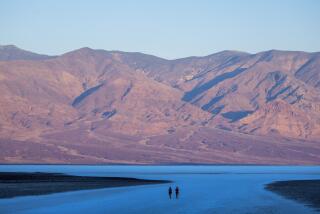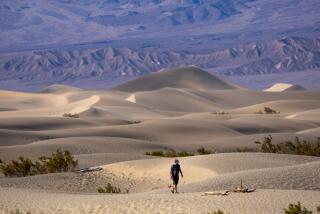Wyoming: Heart Mountain’s chill winds of Japanese American internment
CODY, Wyo. — The drive east of Cody is through high desert, and the February weekend of my visit was bitterly cold. But I was wearing a heavy down coat, snow pants and boots, and riding in a cozy, warm SUV.
That’s not how nearly 14,000 earlier visitors had arrived in Cody. They came by train from California in late August, and they weren’t wearing down or fleece, nor did they have a comfy hotel room awaiting them.
They were among the 100,000 Japanese Americans relocated from the West Coast to the interior of the U.S. at the beginning of World War II, shortly after the Japanese bombed Pearl Harbor. Their home for the next three years would be this windy outpost known as the Heart Mountain Relocation Center, one of 10 Japanese American internment camps.
Heart Mountain, just 50 miles east of Yellowstone National Park, takes its name from a majestic peak near the camp of the same name, but there was nothing romantic about what happened here between August 1942 and November 1945.
Manzanar National Historic Site, nine miles north of Lone Pine, Calif., is the only other place where this chapter of American history is told. But unlike Manzanar, Heart Mountain has several original buildings or parts of buildings that allow for deeper immersion into this story.
Heart Mountain was typical of the Japanese American experience of the day. With 740 acres behind barbed wire, the camp was intended to hold 10,000 citizens, but during its three years, it held more than 14,000 people, including 6,448 from Los Angeles County. Heart Mountain became known as “California’s dumping ground.”
From the outside, the Heart Mountain Interpretive Learning Center, which opened in August 2011, is ugly and depressing, and that’s how it’s supposed to be. The black, barracks-style buildings reflect the design of living quarters hastily assembled for those uprooted from their homes, businesses, communities and lives.
The buildings were so quickly constructed from green timber that within weeks, the wood began to shrink, leaving huge cracks through which the winter winds blew. Black tar paper that wrapped the buildings’ exteriors did little to help against winter’s subzero temperatures — 13 below on Jan. 17, 1943, one exhibit said.
The story of Heart Mountain is told by former internees who helped build this nonprofit facility. One of them, Norman Mineta, grew up to become a U.S. secretary of Commerce and U.S. secretary of Transportation, serving under Presidents Bill Clinton and George W. Bush.
As I entered the visitors center, voices tinged with outrage, alarm and shock greeted me as they read the presidential order that would rip thousands of American citizens from their homes and businesses. They had about a week’s notice to report to the human collection centers, never mind what they would need to do to dispose of their property and settle business affairs.
Visitors to the center receive what appears to be a paper luggage tag. It’s an admission ticket, but each person who reported received one as well. It had to be attached to clothing and displayed at all times until they arrived at Heart Mountain.
For many visitors, the most moving part of the experience is watching the film “All We Could Carry” by Academy Award-winning documentarian Steven Okazaki. The title references the number of personal items that Japanese Americans could bring to Heart Mountain — usually one small suitcase per person.
Personal privacy? Forget it. Six families often lived in one building, separated by a partition or curtain. There was no such screen in the communal toilet and bathing facilities. To re-create that level of discomfort, museum designers installed mirrors in the public restrooms — mirrors positioned in some of the most unusual, disconcerting angles. Nobody could see me do my business, but I got the point and I didn’t like it.
Life took on a rhythm at Heart Mountain. Children attended school in the barracks, Girl Scout and Boy Scout troops were formed, sports teams competed, and more than 550 babies were born. In the spring, internees planted fruit and vegetables in the surrounding government-owned fields. They were paid $21 a month.
Women shopped using the Sears, Roebuck catalog and at some stores in nearby Cody. Teenagers went to the movies on Saturday nights. No one could leave the camp without a pass, and although most internees had money in the bank, most of those assets were frozen for the duration of the war.
Eight hundred men from Heart Mountain were drafted and served in combat in Europe during the war. Fifteen were killed in action; two won the Medal of Honor. Those Japanese American men who refused military service for the government that had incarcerated them in Wyoming were then incarcerated at Ft. Leavenworth, Kan.
The irony is not lost on visitors, who often record their thoughts on those little paper luggage tags and leave them hanging on the barbed-wire fence around the reflection garden.
I was disturbed as I left the visitors center and looked out over the landscape that had been almost as cruel to these individuals as their government.
But I was encouraged that a temporary exhibit was devoted to “Self Portraits of Muslim Americans.” The exhibit changes periodically, and each is devoted to better understanding the story of Heart Mountain’s residents as well as others who have been disenfranchised.
The history lesson told here will endure.
More to Read
Sign up for The Wild
We’ll help you find the best places to hike, bike and run, as well as the perfect silent spots for meditation and yoga.
You may occasionally receive promotional content from the Los Angeles Times.






